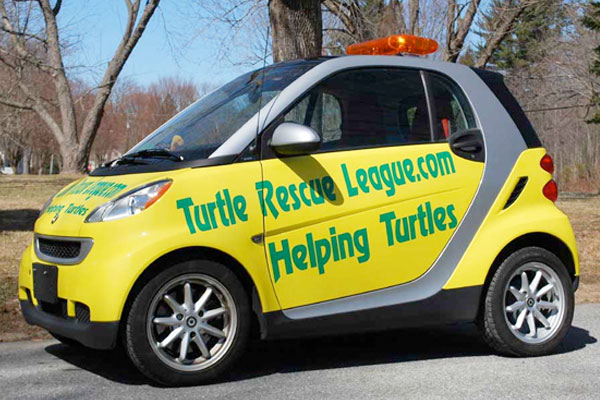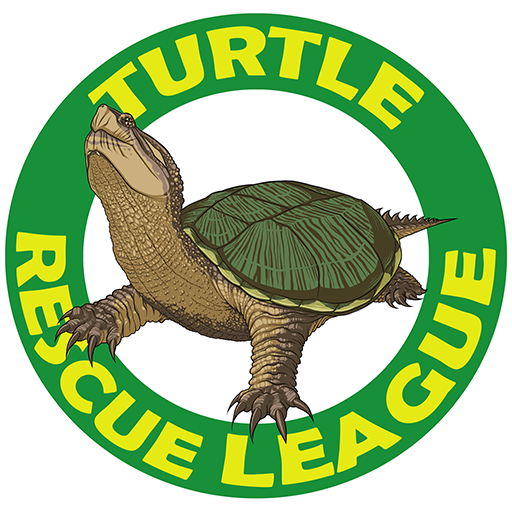I Found An Injured Turtle! What Do I Do?

The most common place to find an injured turtle is along the side of a road. There are many reasons why turtles need to cross roads, and too often, this is where their journeys end. However, turtles are very strong animals; a species cannot survive 280 million years otherwise. DO NOT ASSUME A TURTLE IS DEAD BECAUSE IT IS NOT MOVING. Additionally, there are good reasons to get them to an emergency wildlife center, dead or alive:
- It is incredibly difficult to tell if a gravely injured turtle is alive or dead (even for experts).
- Turtles, especially during the spring and early summer, may be carrying eggs that can be saved even if the mother cannot.
- A mortally wounded turtle can live for hours or days after being injured. It is a great kindness to get them off the hot, noisy street.
- An injured turtle released into the wild without medical treatment will struggle to survive, facing risk of infection, dehydration, and predator attacks. ALL INJURED TURTLES NEED MEDICAL TREATMENT, just like a dog, a cat, or a person.
If you’ve found an injured turtle, you are the first responder
Jump into action! Immediately take the steps below:
- Move the turtle out of harm’s way by CONTAINING it in a dry box. If you do not have a box, put it in any enclosed space available to you. The goal is to prevent an injured turtle from escaping into the wild and/or from suffering additional injuries. IF YOU NEED TO LEAVE THE SCENE RIGHT AWAY, TAKE THE TURTLE WITH YOU. ***If you are able to take photos of the injuries before putting the turtle in the box, this will assist you in further steps.
- Pin the location or write down the address where the turtle was found.
- Click HERE to be contacted by one of our clinicians right away. If you do not wish to wait, call our wildlife hotline at (508) 404-7887. Do NOT try to fix the injuries yourself. This is usually illegal, will complicate recovery and put the turtle through unnecessary pain.
Please note that our clinic is located in Massachusetts. If you are far away from us and need help finding a clinic near you, we are happy to direct you!
FIND A LICENSED WILDLIFE REHABAILITATOR IN YOUR STATE
If you’re not having luck finding a rehabber at the link above, contact us as mentioned in Step 3 above, and we will help!
Determining if a turtle is injured can be difficult
If you are unsure if a turtle is injured, look for some of these tell-tale signs, but remember that it is better to err on the side of caution.
One of the most noticeable signs of injury is a “crack,” or fracture through the shell. You may notice blood on or around the shell, and there may be more than one fracture. When you lift the turtle to bring them to safety, gently look underneath them at their “belly,” or plastron. Sometimes, turtles will have fractures only on their plastron, so it is important to check if you don’t see other signs of injury.
Another common sign of injury is seeing blood around the head, mouth, or arms. When a turtle has an injury to the head, they may pull their head deep into their shell due to fear and pain. Even with their head tucked in, you may be able to see blood, but if you are unsure, gently set them in a box and wait for them to look around. The turtle may take several minutes to be comfortable enough to look around, so be patient!
Turtle injuries can be complex, so be sure to check the surroundings before assuming a turtle is uninjured. Sometimes, there will be blood on the asphalt underneath or nearby the turtle without a clear cause. Blood always indicates an injury, so take action and follow the steps above!
If you are having trouble determining whether or not a turtle is injured, it is best to ERR ON THE SIDE OF CAUTION and treat them as if they are. Take action and follow the steps above!
How to transport injured turtles
The goal is to keep the turtle cool and in the dark. This will keep the turtle as calm as possible during transport. Generally the most practical choice is a box. If you don’t have one, a nearby store may be able to give you one. If you are able, put a dry towel on the floor of the box, and the turtle on top of the towel. If the turtle has been on a hot street it is beneficial to place a slightly damp towel on top of the turtle (never transport a turtle in water- the turtle may drown!). This can also be accomplished with one towel by dampening half, and folding that half over the turtle keeping the dry half under the turtle. Damp paper towels work as well. Keep in mind, it is better to get the turtle to help quickly than to spend too much time trying to make this step perfect.
NEVER TRANSPORT A TURTLE IN WATER-THE TURTLE MAY DROWN!
If you have latex gloves, wear them, if not, washing up well or using hand sanitizer after will keep you safe. If you are regularly helping turtles, keep a “turtle kit” in your vehicle. A kit should contain a box for transporting turtles (use a folded down cardboard box to save room), 2 or 3 medium sized towels, bottled water (for moistening towel as needed), gloves (latex for handling hurt or small turtles) and/or leather garden gloves (if you are dealing with a large or feisty turtles), hand sanitizer (for you and the turtle’s protection).
Handle an injured turtle as little as possible. Stress and the potential of causing harm to an unseen injury will endanger the turtle. A stressed and injured turtle may bite. Stay clear of its head when handling. Be aware of what species of turtle you are helping, a snapping turtle can cause injuries if not handled carefully.

